Therapeutic Edible Clay
Clay provides an impressive assortment of minerals, including calcium,
iron, magnesium, potassium, sulfur, manganese, and silica as well as trace
elements—those appearing in very tiny amounts. Without the basic minerals, life
cannot exist; without the trace minerals, major deficiencies will develop. The lack
of either will make it impossible for the body to maintain good health.
Results from one study carried out in 1998 showed that bentonite clay was
extremely successful at absorbing harmful rotavirus and caronavirus toxins
within the gut of young mammals. Rotaviruses are one of the leading causes
of gastrointestinal distress, such as diarrhea and nausea, in infants and toddlers.
Clay also re-mineralizes cells and tissues, alkalizes the body and is very effective in protecting our
bodies against radiation. "Russian scientists use bentonite to protect
their bodies from radiation when working with nuclear material, by coating their hands
and bodies with a hydrated bentonite "magma" before donning radiation suits.
Dr. Jensen, N.D., D.C., Ph.D.,
suggests using bentonite to absorb radiation from the bones. Since so
many of us are subject to various forms of radiation, whether from
X-rays or television or computers, this would be something to consider.
This could be extremely important for those who have undergone radiation
treatment for cancer. Bentonite adsorbs radiation so well, in fact, that
it was the choice material used to dump into Cherynobl after the nuclear
meltdown in the former Soviet Union.
Studies show that the use of volcanic ash clay internally
goes back to the Indians of the high Andes mountains, tribes
in Central Africa and the aborigines of Australia. Taken
internally, it supports the intestinal system in the elimination
of toxins. The application of clay has achieved miraculous healing
of Buruli Ulcer - mycobacterium ulcerans which is similar to leprosy
and tuberculosis mycobacterium or flesh eating disease.
Clay has been reported to eliminate food poisoning,
colitis, food allergies, viral infections, and parasites. Medicinal clay is
used word wide as an effective treatment for arthritis, cataracts, diabetic
neuropathy, pain, wounds, diarrhea, stomach ulcers, animal and insect bites,
acne, anemia alcoholism and for digestive conditions.
Scientists have discovered that certain clay minerals near hydrothermal
vents at the bottom of the ocean can act as incubators for organic
molecules. Geochemist Lynda Williams, from Arizona State University,
believes her study, published in Geology, shows how some of the
fundamental materials necessary for life might have originally come
into existence. Williams' findings are based on research that
mimicked the conditions found in and around hydrothermal vents.
Related: Evaluation of the
medicinal use of clay minerals as antibacterial agents
Calcium Bentonite Clay is reported to
contain no less than 57 minerals. This impressive
assortment of minerals includes calcium, iron, magnesium, potassium,
manganese, and silica as well as trace elements, those appearing
in very tiny amounts. The mineral content being extremely high sets
the stage for replenishing dietary deficiencies.
Today more than ever before, diets are lacking essential trace minerals and micronutrients.
Without the basic minerals, life cannot exist; without trace minerals,
major deficiencies may develop. Lack of either will make it impossible
for the body to maintain good health and function properly.
In clay
the minerals occur in natural proportion to one another encouraging
their absorption in the intestinal tract. Natural Calcium Bentonite Clay
restores minerals in the tissues where they are needed. Furthermore,
minerals are the carriers of the electrical potential in the cells
which enable the hormones, vitamins, and enzymes to function properly.
Calcium Bentonite, also known as 'living clay',
principally consists of minerals that enhance the production of enzymes in all living organisms.
Calcium Bentonite mineral deposits have been used by Native American healers for centuries
as an internal and external
healing agent. The Native Americans would use mineral rich clay on
open wounds and for stomach or intestinal distress. The key to these benefits is the
natural form in which these minerals are found.
Technically, the clay first adsorbs toxins
(heavy metals, free radicals, pesticides), attracting them to its
extensive surface area where they adhere like flies to sticky paper;
then it absorbs the toxins, taking them in the way a sponge mops
up a kitchen counter mess. Clay’s adsorptive and absorptive qualities
may be the key to its multifaceted healing abilities. Knishinsky
reports that drinking clay helped him eliminate painful ganglion
cysts (tumors attached to joints and tendons, in his case, in his
wrist) in two months, without surgery.
Sodium Bentonite is commonly known as bentonite; the
name is derived from the location of the first commercial deposit
mined at Fort Benton, Wyoming USA. Sodium benonite clays are the
industrial clays used in things like: plaster, oil well drilling
mud, cat litter, matches, cement tiles, lubricating grease, paints,
copy paper, dynamite, shoe polish, concrete, cleaning agents, wall
boards, crayons, and bleaching agents to mention a few.
Pascalite clay is a calcium bentonite, formed thirty
million years ago as the froth and foam of the fiery and convulsive era
atop the Big Horn Mountains in Wyoming. Over the centuries, it captured
the calcium from that limestone formation, and many other minerals
(now known to be vital to life) in trace amounts migrated into it --
manganese, cobalt, copper, etc...Technically, Pascalite is a calcium-based
bentonite. Pascalite is also believed to remove toxins from the body.

Geophagy: Eating Clay
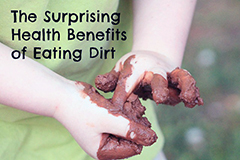 "Earth-eating, or geophagy, is a well-documented
phenomenon. Clay was used during the Balkan war
of 1910 to reduce mortality from cholera
among the soldiers from sixty to three percent.
"Earth-eating, or geophagy, is a well-documented
phenomenon. Clay was used during the Balkan war
of 1910 to reduce mortality from cholera
among the soldiers from sixty to three percent.
In his book, Knishinsky states some of
the benefits reported by people using liquid clay for a
period of two to four weeks include: improved intestinal regularity; relief from chronic constipation, diarrhea, indigestion,
and ulcers; a surge in physical energy; clearer complexion; brighter, whiter eyes; enhanced alertness; emotional uplift;
improved tissue and gum repair and increased resistance to infections.
It has become apparent
that the clay content is often the most important ingredient of selected
soils. Clay is an effective binding agent as its chemical structure allows other chemicals
to bond with it and so lose their reactivity.
Clay is therefore an effective deactivator of toxins from diet or pathogens. Clay is the
primary ingredient of kaolin and kaopectate
that we use when suffering from gastrointestinal malaise.
A very interesting report done by Discover magazine on
Geophagy,
or eating dirt. "Since most humans consume more plant food than
meat, it should come as no surprise that geophagy (from the Greek
roots geo for 'earth' and phagein for 'eat') is also widespread
in peasant communities on all continents, with descriptions going
back to Roman times. In such communities, pregnant and lactating
women especially crave soil, typically consuming one-and-a-half
ounces or more per day."
 Dextreit writes that clay stimulates the deficient organ
and help the restoration of the failing function. Clay is a powerful
agent of stimulation, transformation and transmission. Clay contains
highly active ingredients, able to induce cellular rebuilding and
to hasten all organic processes. He also says that clay acts with
wisdom - it goes to the unhealthy spot.
Dextreit writes that clay stimulates the deficient organ
and help the restoration of the failing function. Clay is a powerful
agent of stimulation, transformation and transmission. Clay contains
highly active ingredients, able to induce cellular rebuilding and
to hasten all organic processes. He also says that clay acts with
wisdom - it goes to the unhealthy spot.
Used internally, whether
absorbed orally, anally or vaginally, clay goes to the place where
harm is, there it lodges, perhaps for several days, until finally
it draws out the pus, black blood, etc. with its evacuation.
Calcium montmorillonite
and other types of clays attracts and neutralizes poisons in the
intestinal tract. It can eliminate food allergies, food poisoning,
mucus colitis, spastic colitis, viral infections, stomach flu, and
parasites (parasites are unable to reproduce in the presence of
clay).
There is virtually no digestive disease that clay will not treat.
It enriches and balances blood. It adsorbs radiation (think cell phones,
microwaves, x-rays, TVs and irradiated food, for starters). It has been used
for alcoholism, arthritis, cataracts, diabetic neuropathy, pain treatment,
open wounds, diarrhea, hemorrhoids, stomach ulcers, animal and poisonous
insect bites, acne, anemia, in fact, the list of uses is too long for this article.

Animals Eat Clay for Minerals and as Medicine
 Pets are helped, too. Recently more information has become available outlining the important role clay can play in
the recovery and maintenance of health. Many wild animals, and some people, develop , pica' when ill, a
craving to eat earth - particularly clay, which assuages diarrhea and binds to many plant poisons.
Pets are helped, too. Recently more information has become available outlining the important role clay can play in
the recovery and maintenance of health. Many wild animals, and some people, develop , pica' when ill, a
craving to eat earth - particularly clay, which assuages diarrhea and binds to many plant poisons.
Among the most famous
clay-eaters are the parrots of the Amazon. Scarlet macaws, blue and gold macaws, and hosts of smaller
birds perch together in their hundreds to excavate the best clay
layer along a riverbank. Parrots' regular diet is tree seeds,
which the trees defend with toxic chemicals, and clay is an essential buffer to the toxins. Edible healing clays have been
shown to be able to literally pull pollutants out like a magnet, getting rid of years of toxic accumulation.
Rancher Observes Cattle eating clay
Bill Roundy is a retired rancher. He remembers a generation ago, when he lived in Utah, that
he and other cattle ranchers, learned a valuable lesson by watching
their cattle. Whenever a cow got sick and went off her food, the
ranchers would turn her out to fend for herself, as they could not
afford to throw good money after bad. But, they noticed that, time
and time again, the cows would return after a few days, fully recovered,
and ready to feed with the rest of the herd. It wasn't long before
these ranchers discovered how the cows were recovering. The sickly
cattle would take themselves across the desert to clay banks, and
feed on them until their health returned. When the ranchers saw
how easy and cheap was the solution, they transported to their
sick cows - a practice still continued today.
Birds eat soil to bind and deactivate plant toxins
 Many species of mammals, birds, reptiles, and even insects, in
all parts of the world, eat dirt. In the animal world, parrots seek out particular clays and deer lick
hollows into patches of soil, traveling long distances to reach these tasty spots.
Cattle will chew on clods of particular earths;
in South Africa, cattle will often be found meditatively licking away at termite nests,
hollowing out polished scoops in any weak
spots. Termite nests are rich in trace elements, as these "white ants" carry up fragments
from as much as a hundred feet down."
Many species of mammals, birds, reptiles, and even insects, in
all parts of the world, eat dirt. In the animal world, parrots seek out particular clays and deer lick
hollows into patches of soil, traveling long distances to reach these tasty spots.
Cattle will chew on clods of particular earths;
in South Africa, cattle will often be found meditatively licking away at termite nests,
hollowing out polished scoops in any weak
spots. Termite nests are rich in trace elements, as these "white ants" carry up fragments
from as much as a hundred feet down."
"Deep in the rain forests of New Guinea, Jared Diamond was surprised
to see parrots, pigeons and crows fly down to a new landslide of
earth and eat the bare dirt. The birds flocked to this rare opportunity
to access bare earth in an area densely covered with vegetation.
Not all of the observed 140 bird species came down to eat earth.
Only the eight herbivorous species that regularly ate fruit, seeds
and flowers.
Plants naturally contain numerous toxins that protect
them from predators and pathogens. When the landslide soils were
analyzed they were found to contain less minerals than the surrounding
top soil but again the clay content was high and, what is more,
found to be more effective at binding alkaloids and tannins than
pure pharmaceutical kaolinite. These birds were taking advantage
of newly disturbed earth and selecting soil of just the right properties
to bind and deactivate plant toxins." [Diamond,J 1998
Eat Dirt: in the competition between parrots and fruit trees,
it's the winners who bite the dust. Discover. 19(2) pp70-76.].

The Mud That Heals
"The Native Americans call it "Ee-Wah-Kee" meaning "The-Mud-That-Heals"
Bentonite, as well as other types of healing clay, has been used by
indigenous cultures since before recorded history. "The Amargosians
(predecessors to the Aztecs ), the Aborigines, and natives of Mexico
and South America all recognized the benefit of clays. " "...healing
mud not only draws toxic material out of the body if taken internally,
but also reduces pain and infection in open wounds on both humans and animals."
Knishinsky writes that clay is part of his diet and he never skip
a day without eating clay. He writes "When clay is consumed, its
vital force is released into the physical body and mingles with
the vital energy of the body, creating a stronger, more powerful
energy in the host. The natural magnetic action transmits a remarkable
power to the organism and helps to rebuild vital potential through
the liberation of latent energy. When the immune system does not
function at its best, the clay stimulates the body's inner resources
to awaken the stagnant energy. It supplies the body with the available
magnetism to run well. Clay is said to propel the immune system
to find a new healthy balance and strengthens the body to a point
of higher resistance."
Naturally absorbent and extremely gentle on the system, clay
can treat ailments affecting digestion, circulation, menstruation,
and the liver, skin, and prostate. Clay also remedies symptoms of
arthritis, chronic fatigue syndrome, gum diseases, and migraines.
Ran Knishinsky says that he eats clay everyday, that it is part
of his diet. He never skip a day without eating clay. On page 95
suggests the following : infants: 1/4 to 1/2 teaspoon (in a bottle),
Small frame: one teaspoon, Medium frame: one heaping teaspoon, Large
frame: one tablespoon.
Therapeutic Clay Bath Treatment for Health and Detoxification
Since antiquity people have used clay and mineral baths for detoxing and healing.
Over the course of time there have been untold numbers of people that have attributed healing benefits to these therapeutic baths.
Today we can experience these healing baths in the convenience of our own home.
Soaking in a bath with calcium Bentonite clay is the mineral hydrotherapy solution coveted by
those who visit the most celebrated health spas.
A therapeutic clay bath is exceptionally detoxifying
and nourishing to the skin plus the cleansing benefits of a clay bath are effective in ways that bath salts cannot be.
When you languish in a mineralized colloidal clay bath, your body is immersed in microscopic particles that transport
nutrients to your skin and helping to pull unhealthy metals, chemicals and toxins from your body
with a powerful ionic transdermal cleanse.
The negatively charged clay particles attract the positively charged toxins and
heavy metals very effectively supporting the detoxifying process.A therapeutic clay bath can revitalize personal
energy, and restore your tranquility, stamina and spirit. The therapeutic revitalization will stimulate immune system support as an
added benefit completing the rejuvenating experience.
Testimonial of Glorious Mud
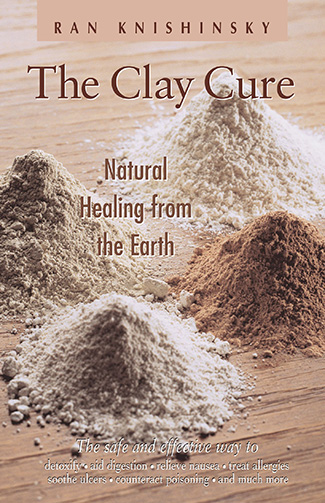 I started taking clay in June 2005. I read an article
in California Wild magazine, the Winter 2005 issue,
titled Mud, Mud, Glorious Mud. The magazine is published by The
California Academy of Sciences. I was quite impressed with the
history of our ancestors, and the history of animals who
instinctively crave clay, which 'cleanses' our bodies
of some of the junk type foods that we all ingest, including
animals that may eat semi-toxic plants. The article stated that
clay was the best substance to rebuild the bone loss suffered by our first astronauts. I have
Osteoporosis, therefore I
started taking your clay. Results of my bone density will
not be known until May 2007.
I started taking clay in June 2005. I read an article
in California Wild magazine, the Winter 2005 issue,
titled Mud, Mud, Glorious Mud. The magazine is published by The
California Academy of Sciences. I was quite impressed with the
history of our ancestors, and the history of animals who
instinctively crave clay, which 'cleanses' our bodies
of some of the junk type foods that we all ingest, including
animals that may eat semi-toxic plants. The article stated that
clay was the best substance to rebuild the bone loss suffered by our first astronauts. I have
Osteoporosis, therefore I
started taking your clay. Results of my bone density will
not be known until May 2007.
However, to my surprise,
I have not had a cold or the flu since I started taking Clay.
For the first time in my adult life (I am now 67 years old), I have not had my once
or twice yearly cold, sinus infection, or respiratory problems.
My wife had several bad colds the winter of 2005 - 2006, and I did
not get sick! I have never taken any other "alternative"
health product. Clay definitely works for me. I quit taking Clay
for several days in the spring of 2006, and I started to develop
breathing problems and a sore throat. I went back to the Clay,
and I am healthy again!" Paul Juilly, San Francisco, CA.
The use of volcanic ashes and clay internally is almost older than civilization
itself. Primitive tribes of various continents have used various types of clay
for conditions of toxicity. Dr. Weston A. Price in
his book, "Nutrition and Physical Degeneration", stated that in studying
diets of certain tribes he examined their knapsacks. Among those
examined in the high Andes, among those in Central Africa and among
the Aborigines of Australia he reported that some contained balls
of clay, a little of which was dissolved in water. Into the clay
were dipped morsels of food. The explanation was that this was to
prevent "sick stomach".
These people were reported to use the clays
for combating dysentery and food infections. In South America he
found that the Quetchus Indians, believed to be descendants of the
once powerful Incas, were largely vegetarians and he stated, "Immediately
before eating, their potatoes are dipped into an aqueous suspension
of clay, a procedure which is said to prevent 'souring in the stomach'."
Yet, only comparatively recently has the white man apparently begun
to use kaolin, one of the clays.

Clays Exhibit Novel Antibacterial Properties
Beauty treatments that use clay aren't new, but clay-based medicinal
treatments are. And if Arizona State University's (ASU) Lynda Williams
and Shelley Haydel's research pans out, then clay might one day
become an antibacterial standard like penicillin. "We use maggots
and leeches in hospitals, so why not clay?" Haydel asks. The ASU
duo have just received a substantial grant from the National
Institutes of Health that will allow them to examine the mechanisms
that allow two clays mined in France to heal Buruli
ulcer, a flesh-eating bacterial disease found primarily in central
and western Africa. Buruli ulcer (related to leprosy) is caused
by Mycobacterium ulcerans, which produces a toxin and destroys the
fatty tissues under the skin. It was recently declared to be "an
emerging public health threat" by the World Health Organization (WHO).
"Ordinary clay can kill the drug-resistant superbug
MRSA -- methicillin-resistant Staphylococcus aureus, and other
lethal infections, and is being investigated as a potential tool
in treating patients. "Healing" clays have been known for years
to soak up toxins produced by bacteria, which can limit the spread
of infection. But now, research at Arizona State University shows
some forms of clay actually kill salmonella, E. coli, MRSA and ulcerans, which causes flesh-eating disease. If they can figure
out how it works, this could make a cheap, low-tech weapon against
infection available throughout the Third World." The Calgary Herald 2008
Ancient art of Clay Therapy (Pelotherapy)
Cano Graham is among the foremost activists and authorities in the United States concerning the ancient art
of Clay Therapy (Pelotherapy). The very soul of his book is the
unimaginable healing spectrum, both internally and externally, of
modern clay therapy. This healing phenomenon moves through dozens
of inspiring human-interest tales, beginning in 1987 with Mr. Graham's
odyssey of building the original Crystal Cross Therapeutic Clay
Center in Tecopa Hot Springs, California. In Tecopa, the loveable
old-timers exposed him to an "amazin' healing' mud," and his life
was forever altered.
Pascalite Clay - a calcium bentonite clay from the Big Horn Mountains
of Wyoming
Pascalite is a calcium bentonite, formed thirty million years
ago as the froth and foam of the fiery and convulsive era atop the
Big Horn Mountains in Wyoming. Over the centuries, it captured the
calcium from that limestone formation, and many other minerals (now
known to be vital to life) in trace amounts migrated into it --manganese,
cobalt, copper, etc...
Users of Pascalite have reported many dramatic health enhancing
results from this enigmatic substance. Pascalite has been found
to have many uses in promoting health in plants, animals and humans.
One theory regarding the benefits of Pascalite is that its broad
base of minerals serves as an excellent mineral supplement. Technically,
Pascalite is a calcium-based. bentonite. Pascalite is believed to
not only remove toxins from the body but also to build up the immune
system. It is thus possible - perhaps even probable - that this
combination may reduce the body’s sensitivity to toxins.
Pascalite is hand mined underground to avoiding contamination,
and then solar dried in the high mountain to preserve it's apparent
antibiotic qualities. It is then turned into powder to make it readily
usable for both internal and external purposes. Please do not confuse
Pascalite with ordinary clays such as bentonite, Jordan clay or
French green clay. Though listed as a calcium bentonite, at least
one government agent has hinted it may well be an as-yet-unidentified
material outside the scope of present knowledge. Dr Walter Bennett,
Ph.D., who investigated it in depth, stated it was still "a very
mysterious substance".
One research group gives a possible explanation as to why Pascalite
differs form other clays. It lies relatively near the famous, mysterious
Big Horn Medicine Wheel, which dates back to antiquity. "We feel
medicine wheels were build on vortex areas where earth energies
surface intensely, and the Pascalite contains that same intense
energy."
Pascalite is used in soap and toothpaste, applied as a poultice
to insect bites, sunburns, infections, cold sores, canker sores
and acne, and as a suppository for hemorrhoids. Users found it a
potent skin cleanser and conditioner, drank it for heartburn and
ulcers. One neglected mineral in Pascalite, lately recognized as
vital to living tissue, is silica. It is found in Pascalite as silicate
and silicones. In the body silica occurs as collagen, a connective
tissue covering the brain, spinal cord, and the nerve systems. It
is an essential part of hair, skin and nails. Some researchers have
hinted that a lack of silica in the brain and nerves may be one
cause of poor memory.
It has many other uses, many beauticians state it has no equal
as a facial conditioner. They report that
it's skin-tightening effect when used on the face is so strong as
to be almost painful. We have been told that when PASCALITE pulls
the red blood cells to the skin surface, leaving your face temporarily
red, it has done it's job.
In addition to its other abilities, pascalite has been shown
to be an anesthetic. Many users have reported almost immediate cessation
of pain following its application in paste form to the areas.

Healing Buruli Ulcer with Clay
Devastating Buruli Ulcer is caused by mycobacterium ulcerans which is similar
to leprosy and tuberculosis. Scientists around the world have tried
for over 40 years to find a cure, but failed. Only a very traumatic
surgical operation offers some form of relief.
Thierry Brunet de Courssou Missillac: "My mother aged 73 has found an
effective treatment using clay, thanks to her courage and perseverance
spending a full year in a remote village in Africa taking care of
these unfortunates infected people. The spectacular results, even
of the worse clinical cases, have been acknowledged by WHO (World
Heath Organization) last March. Continuation of my mother's work
is planned over the next 2 years. All the details are available
on our website especially setup to keep the public informed in real time.
It has always been believed, but never proven that French clay
can kill several varieties of bacteria that cause diseases. Today,
a researcher at Arizona State University at Tempe is leading a study
to show why certain minerals kill certain bacteria.
French clay has been shown to kill Mycobacterium ulcerans, or
M. Ulcerans, which is so epidemical in Africa. It also treats Methicillin-resistant
Staphylococcus aureus (MRSA), which is responsible for deadly infections
that are difficult to treat. Furthermore, it has been known for
thousands of years that people have used clay for healing wounds,
helping indigestion, and killing intestinal worms. Scientists are
starting to look further into ancient remedies to see what exactly
they do and how they work because their encounters with germs that
are resistant to drugs are a serious problem.
Lynda Williams, associate research professor at Arizona State
University at Tempe in the School of Earth and Space Exploration
is leading three teams of researchers in studying healing clays.
The other two teams are from the United States Geological Survey
(USGS) and The State University of New York at Buffalo (SUNY-Buffalo).
Laboratory tests conducted at Arizona State University's Biodesign
Institute have already shown that French clay, one type of clay,
kills bacteria responsible for Staphylococcus aureus, methicillin-resistant
Staphylococcus aureus (MRSA), penicillin-resistant Staphylococcus
aureus (PRSA), and E. coli. It also kills Mycobacterium ulcerans,
which is a germ related to leprosy and tuberculosis. The germ causes
Buruli ulcer. The bacteria produce a toxin that destroys the immune
system, skin, tissues, and bones.
Line Brunet de Courssou, a French humanitarian working in the
Ivory Coast, Africa, first reported the effects French clay has
on Buruli ulcer in 2002. de Courssou had been familiar with the
effects of French clay since childhood and found that she could
cure Buruli by applying it to the infected person every day. The
only other method science has of treating Buruli ulcer is by surgically
removing the infected area or amputating the infected limb.
The findings on the medical benefits of French clay will be reported
at the Geological Society of America Annual Meeting in Denver, Colorado
on October 29, 2007. They will also present the work of a German
physician named Julius Stumpf who, one hundred years ago, used white
clay from Germany to treat a form of cholera from Asia that is deadly.
He also used it to treat diptheria, gangrene, eczema, and ulcers
on shin bone, or tibia.
Dr. Janet Starr Hull - "French Green
Clay is virtually unknown in America as an internal detoxification
supplement, yet Europeans have used it internally for thousands
of years to remove the causes of disease symptoms. In 1986 after
the meltdown of the Soviet nuclear power plant, Chernobyl, the Soviet
Union put French Green Clay in chocolate bars and dispensed them
freely to the masses to remove radiation they may have been exposed
to. Found only in France and India, the ancient sea beds that provide
the green clays have healing qualities that not only attach themselves
to and remove toxic foreign substances within the body, but activate
the body's own immune system through its chemical constitution.
Green clays contain magnesium, calcium, potassium, manganese, phosphorous,
zinc aluminum, silicon, copper, selenium, cobalt,
micro-algaes, algae, and phyto-nutrients.
French green clay has the ability to remove toxic metals and chemical
residues, bacteria, and blood toxins with virtually no side effects
of constipation, diarrhea, or stomach cramping. It is known to remove
radiation, arsenic, lead, mercury, and aluminum amid other toxic
metals in less than six weeks. The more you use, the quicker you
detox."

Adsorption versus Absorption
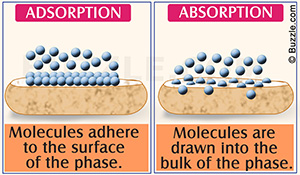 The two words look alike, but their difference is critical in understanding the functions of clay minerals.
The two words look alike, but their difference is critical in understanding the functions of clay minerals.
Adsorption characterizes the process by which substances stick to the outside
surface of the adsorbent medium. The clay possesses unsatisfied
ionic bonds around the edges of its mineral particles. It naturally
seeks to satisfy those bonds. For this to happen, it must meet with
a substance carrying an opposite electrical (ionic) charge. When
this occurs, the ions held around the outside structural units of
the adsorbent medium and the substance are exchanged.
The particles of clay are said to carry a negative electrical
charge, whereas impurities, bacteria, or toxins, carry a positive
electrical charge. For this very reason clay has been used to adsorb
the colloidal impurities in beer, wine, and cider. The impurities
in wine carry positive charges and can be agglomerated (brought
together) and removed by stirring a small amount of negatively charged
clay material into the wine. The clay particles attract the wine
impurities and they settle out together (flocculate).
The process works the same in the human body. When clay is taken
internally, the positively charged toxins are attracted by the negatively
charged surfaces of the clay mineral. An exchange reaction occurs
whereby the clay swaps its ions for those of the other substance.
Now, electrically satisfied, it holds the toxin in suspension till
the body can eliminate both.
The term active, or alive, indicated the ionic exchange capacities
of a given clay mineral. The degree to which the clay-mineral ions
become active determine its classification as alive. Living bodies
are able to grow and change their form and size by taking within
them lifeless material of certain kinds, and by transforming it
into a part of themselves. No dead body can adsorb. It is physically
impossible.
Absorption
is a much more slow and involved process than adsorption.
Here, the clay acts more like a sponge, drawing substances into
its internal structure. In order for absorption to occur, the substance
must undergo a chemical change to penetrate the medium's barrier.
Once it has done that, it enters between the unit layers of the
structure. Instead of the toxins, for instance, sticking only to
the surface, they are actually pulled inside the clay. This is the
reason why absorptive clays are labeled expandable clays. The more
substances the clay absorbs into its internal structure, the more it expands and its layers swell.
Any clay mineral with an inner layer charge is an absorbent. Having
an inner layer charge means having charged ions, sitting between
layers, that are surrounded by water molecules. In this way, the
clay will expand as the substance to be absorbed fills the spaces
between the stacked silicate layers. Some clays are more gentle
in their absorption, whereas others are definitely more radical.
Absorption takes place with clay when the clay draws particulates
into its internals layered structure, much like a sponge. Clay minerals
have an inner layer charge that acts like an absorbent and can absorb
and bond with many elements that are toxic, both man-made and natural.

Small Platelets of Clay Particles
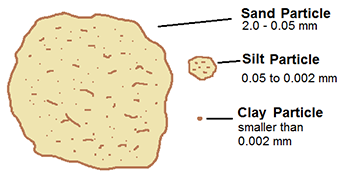 The smaller the particle size of clay,
the more platelets there
are per given cubic centimeter of volume or unit of weight and the
larger the total surface area is. Their absorbent and adsorbent
capacity increases with the numbers of clay platelets per given
unit of measure. The natural parent size of clay particles as created
by nature is fixed. The industrial process of crushing, grinding,
milling, etc, will not change the parent particle size once created.
They do clump or bond together many times making them larger in
size, however processing it mechanically can make them no smaller
than nature originally created.
The smaller the particle size of clay,
the more platelets there
are per given cubic centimeter of volume or unit of weight and the
larger the total surface area is. Their absorbent and adsorbent
capacity increases with the numbers of clay platelets per given
unit of measure. The natural parent size of clay particles as created
by nature is fixed. The industrial process of crushing, grinding,
milling, etc, will not change the parent particle size once created.
They do clump or bond together many times making them larger in
size, however processing it mechanically can make them no smaller
than nature originally created.
On a molecular level, Robert T. Marin, a mineralogist at MIT,
points to Bentonite’s minute particle size that creates a large surface area in proportion to
the volume used. “The greater the surface area,
the greater its power to pick up positively charged particles of ions.” Mr. Marin stated that one gram of clay has a
surface area of 800 square meters. That equates to about 8 football fields in size. Thus the
greater the surface area, the greater
the power to pick up positive charged ions many times its own weight (free radicals are positively charged for example).
Clays are like people, there are no two alike. Each clay deposit
on earth has its own fingerprint. This unique identity is comprised
of its particular composition of the elements on the periodic table,
different ratios to one another, different ionic electrical charge,
different particle size, different purity, different exposure for
a different amount of time, to mention a few of the differences.
As a result of some of these differences, they react accordingly
different when applied or utilized. Some clays “work”, while others
do not or at least, not very well for the intended purpose, depending
on what that purpose is. Examples of such purposes that the beneficial
effects clay provides are: industrial manufacturing, cosmetic and
paint base, paper coating, cleansing, detoxifying, polymer resin
nanotechnology, agriculture, aquaculture, nutritional supplement
for people and animals, ponds and waterways flocculation cleanup,
and much more. As a result of the many various uses of this simple
but yet very complex compound, the net effective difference between
clays has a direct relationship to cost.

Volcanic Clay May Have Served As Womb For Emergent Life
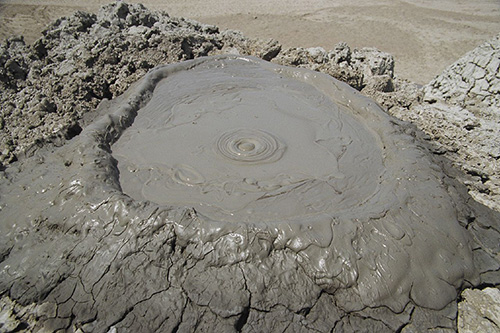 Scientists have discovered
that certain clay minerals near hydrothermal vents at the bottom of the ocean can act as incubators for organic
molecules. Geochemist Lynda Williams, from Arizona State University,
believes her study, published in Geology, shows how some of the
fundamental materials necessary for life might have originally come
into existence. Williams' findings are based on research that mimicked
the conditions found in and around hydrothermal vents.
Scientists have discovered
that certain clay minerals near hydrothermal vents at the bottom of the ocean can act as incubators for organic
molecules. Geochemist Lynda Williams, from Arizona State University,
believes her study, published in Geology, shows how some of the
fundamental materials necessary for life might have originally come
into existence. Williams' findings are based on research that mimicked
the conditions found in and around hydrothermal vents.
Studies show that the use of volcanic ash clay internally goes
back to the Indians of the high Andes mountains, tribes in Central
Africa and the aborigines of Australia. Taken internally, it supports
the intestinal system in the elimination of toxins. The application
of clay has achieved miraculous healing of Buruli
Ulcer - mycobacterium ulcerans which is similar to leprosy and
tuberculosis mycobacterium or flesh eating disease.
Clay May Have Been Catalyst For Life
Howard Hughes Medical Institute (HHMI) researchers have discovered
that
clays may have been the catalysts that spurred the spontaneous
assembly of fatty acids into the small sacs that ultimately evolved into the first living cells.
Fine-grained crystals of clay might, all by themselves,
have been the very first life forms on Earth. According to this hypothesis, self-replicating clay
crystals evolved the ability to
manufacture complex biomolecules such as RNA, which eventually out-competed
their clay cousins to become the dominant form of life on the planet.

Incredible True Stories Of People That Use Clay
A patient taking 2 no. 00 capsules of powder by mouth four times
a day removed all symptoms of an active ulcer and hyper-acidity in 7 days.
A wet pack applied to corns and callouses on and between the
toes was left on 3 days, then changed and left on 3 more days. All
symptoms were relieved, and the corns had disappeared.
Used as a water-and-Pascalite pack on the face and arms of an
explosion-burn victim, it relieved the pain almost immediately and
these areas did not blister. The hands, given conventional treatment,
did blister.
 Three individuals stated under oath that topical use of Pascalite
paste had removed all symptoms of hemorrhoid in 2 to 4 nightly applications.
Many other have reported similar results in uts use for piles, rectal
fissures and related conditions.
Three individuals stated under oath that topical use of Pascalite
paste had removed all symptoms of hemorrhoid in 2 to 4 nightly applications.
Many other have reported similar results in uts use for piles, rectal
fissures and related conditions.
Kit Nelson of Scottsdale, Arizona explains how Pascalite cured
her 22-year old daughter of a serious case of chicken pox: "she
was very ill and covered from head to toe with pox which nearly
drove her crazy because of the itching and irritation. In desperation
she mixed Pascalite with water to a thin consistency and applied
it to her body. In a matter of hours ( ! ) the healing set in and
she had complete rest and relief. Her recovery was fast and her
skin remained lovely - the pox left no scars, which was a miracle."
A Vietnam veteran, returning home a hopeless addict and alcoholic,
so desperate that he contemplated suicide, and was willing to try
anything, was persuaded to take some Pascalite internally. He noticed
from the first day that he began drinking Pascalite and water, his
compulsion to drink slowly left him. Shortly his life did a complete
turn-around. He not only lost his alcohol dependency, but also his
addiction to dope. He then met another Vietnam vet suffering the
same double addiction. He got the fellow to use Pascalite as well,
and the results were the same!
Horse helped by clay
Date: Thu, 26 Jan 2006
Name: Lynn Lawrence
Location: Surrey, British Colombia
I Thank-you for all of the great information you provide on your
site, especially the information on clay. I had always wondered
why my mare was digging holes and eating mouthfuls of dirt. I new
there was a mineral deficiency in her diet, but what she was also
telling me was she was trying to detox. The clay has supplied the
answer to both. My mare gets the best quality hay, whole foods as well as flax,
blue green algae etc. But
her diet, as with mine falls short because of our top soil.(To bad
the price doesn't fall short as well).I have also noticed a sense
of well being, that is starting to return. The day I received my
clay one of the mares in the barn had her leg blow up for no apparent
reason the Vet. could offer nothing. This mares back leg was four
times the normal size, I have never seen this before, and I had
a bad feeling in my stomach. I got some clay in a bucket, mixed
with water and poulticed her leg from top to bottom, the instant
the clay touched her leg she dropped her head and started licking
her lips, by morning the inflammation had been reduced to half. I
started the clay in her food, and she started to "pick up". I know
in my heart that the clay saved her life. I am so grateful that the day I was faced with this I had something
to offer!!! Warmest regards
Eaton's Amazing Healing Experience with Clay
Jason R. Eaton, developed a severe skin condition in 1988 which
no dermatologist could cure. "After a host of antibiotic and acid
treatments, I left the comforts of the realm of modern medicine
in search of an alternate solution. The period 1989 - 1993 marked
a time of extensive research into metaphysics, which eventually
led to my own personal discovery of Bentonite late in 1993, where
I literally stumbled into a natural deposit in the middle of the
night! On that same autumn evening I tried an application of this
natural clay while soaking in a well hidden natural hot spring pool
deep in the far and silent reaches of the Mojave Desert. Within
five minutes I experienced the first pain-free moment in four years."

Question about Aluminum Hydroxide in edible clays and soils
Elements on the periodic table, including aluminum hydroxide,
lead, copper, chromium, mercury, strontium, etc., in the natural
form, are totally different than these same elements after they
are transformed by industrial processes for manufacturing and commerce.
The molecular rearrangement of these elements in the refining process
isolates aluminum molecules for example, to make airplane parts
or frying pans for commerce. This refining procedure changes the
original natural elemental molecular structure by industrial processing
through rearranging the natural elemental form to an isolated man
made form. As a result of this process, many times this alteration
of elements transform them into elements that are sometimes harmful
or toxic to life forms.
Certain edible clays and soils in the natural and unaltered form
are inert and safe for life, like food and water (H2O). Water is
a natural compound and if one were to separate the hydrogen molecule
from water by the refining process, it could be used to fuel cars
of the future or make bombs and therefore is not only harmful and
toxic but lethal. If one were to take a spoonful of earth from their
own back yard and have it chemically analyzed, they would find many
of these same elements. When chemically rearranging these elements
by the refinement process, they also become harmful or highly toxic.
The elements on the periodic table may be altered by many industrial
processes through molecular isolation (separation) and further combined
with other elements and chemical procedures to make products. An
example in metals, alloys area among the most common combination
for things like tool steel in knifes and machines. Many factory
or man made drugs also fall into this group. Many times both are
harmful or even toxic to plant, animals, humans as well as the environment
itself.
Molecular rearrangement, isolation, and combining other refined
elements making industrial/factory compounds are totally different
than elements found in nature. Throughout the world, soils that
contain different minerals and clays are what plants utilize for
growth and life itself. The nutrients in these soils transfer into
plants by a process called plant root nutrient uptake. As a result,
what elements found in plants come from the soil and the soil contains clay.
If the plants that animals and humans eat to live are harmful
or toxic, then plant, animal and human life would not be on earth
as we know it. Certain edible clays, calcium montmorillonite clay) when ingested
are like food and water, is not only safe but provide many natural
health benefits, including a high nutrient source, detoxification,
PH and blood balance, colon cleansing, assist in total body healing,
to mention a few.